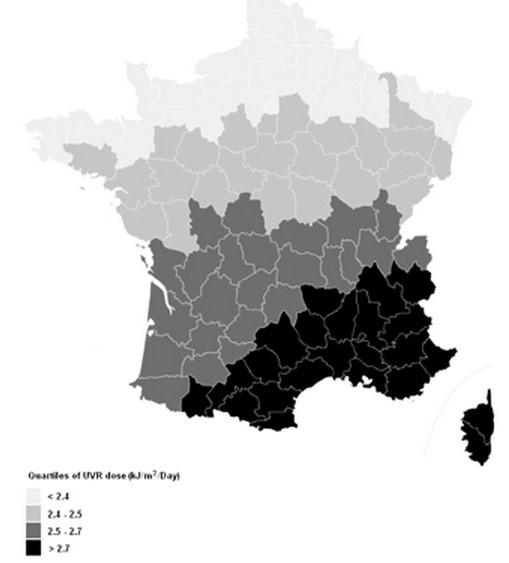More than an hour of daily sun associated with 30 percent less ERplus Breast Cancer
Sun Exposure, Vitamin D Receptor Genetic Variants, and Risk of Breast Cancer in the Agricultural Health Study
Environ Health Perspect 122:165–171; http://dx.doi.org/10.1289/ehp.1206274
Lawrence S. Engel,1 Jaya Satagopan,2 Camelia S. Sima,2 Irene Orlow,2 Urvi Mujumdar,2 Joseph Coble,3 Pampa Roy,2 Sarah Yoo,2 Dale P. Sandler,4 and Michael C. Alavanja3
1Department of Epidemiology, University of North Carolina Gillings School of Global Public Health, Chapel Hill, North Carolina, USA;
2Department of Epidemiology and Biostatistics, Memorial Sloan-Kettering Cancer Center, New York, New York, USA;
3Division of Cancer Epidemiology and Genetics, National Cancer Institute, National Institutes of Health, Department of Health and Human Services, Bethesda, Maryland, USA;
4National Institute of Environmental Health Sciences, National Institutes of Health, Department of Health and Human Services, Research Triangle Park, North Carolina, USA
PDF is attached at the bottom of this page
(Was unable to extract the abstract from the PDF, sorry)

Regions with highest UV had 30% less Breast Cancer - Jan 2011
Joint effects of dietary vitamin D and sun exposure on breast cancer risk: results from the French E3N cohort
Cancer Epidemiol Biomarkers Prev. 2011 Jan;20(1):187-98. doi: 10.1158/1055-9965.EPI-10-1039. Epub 2010 Dec 2.
Engel P1, Fagherazzi G, Mesrine S, Boutron-Ruault MC, Clavel-Chapelon F.
Abstract
BACKGROUND:
Ecological studies have suggested that vitamin D production through ultraviolet (UV) solar irradiance could reduce breast cancer (BC) risk. Although studies restricted to dietary vitamin D intake have provided inconsistent results, little is known about the relationship between pre- and postmenopausal BC and combined intakes from diet, supplements, and sun exposure.
METHODS:
Cox proportional hazards regression models evaluated the association between vitamin D intakes, mean daily ultraviolet radiation dose (UVRd) at the place of residence and risk of BC among 67,721 women of the French E3N cohort. All analyses were stratified on menopausal status taking into account important confounders including calcium consumption.
RESULTS:
During 10 years of follow-up, a total of 2,871 BC cases were diagnosed. Dietary and supplemental vitamin D intakes were not associated with BC risk; however, in regions with the highest UVRd, postmenopausal women with high dietary or supplemental vitamin D intake had a significantly lower BC risk as compared with women with the lowest vitamin D intake (HR = 0.68, 95% CI: 0.54-0.85, and HR = 0.57, 95% CI: 0.36-0.90, respectively).
CONCLUSION:
Our results suggest that a threshold of vitamin D exposure from both sun and diet is required to prevent BC and this threshold is particularly difficult to reach in postmenopausal women at northern latitudes where quality of sunlight is too poor for adequate vitamin D production.
IMPACT:
Prospective studies should further investigate associations between BC risk, vitamin D status and sunlight exposure.
©2011 AACR.
PMID: 21127286

PDF is attached at the bottom of this page
See also VitaminDWiki
Cancer - Breast category listing with associated searches
Breast Cancer items
-
The TOP articles in Breast Cancer and Vitamin D are listed here:
{category}
